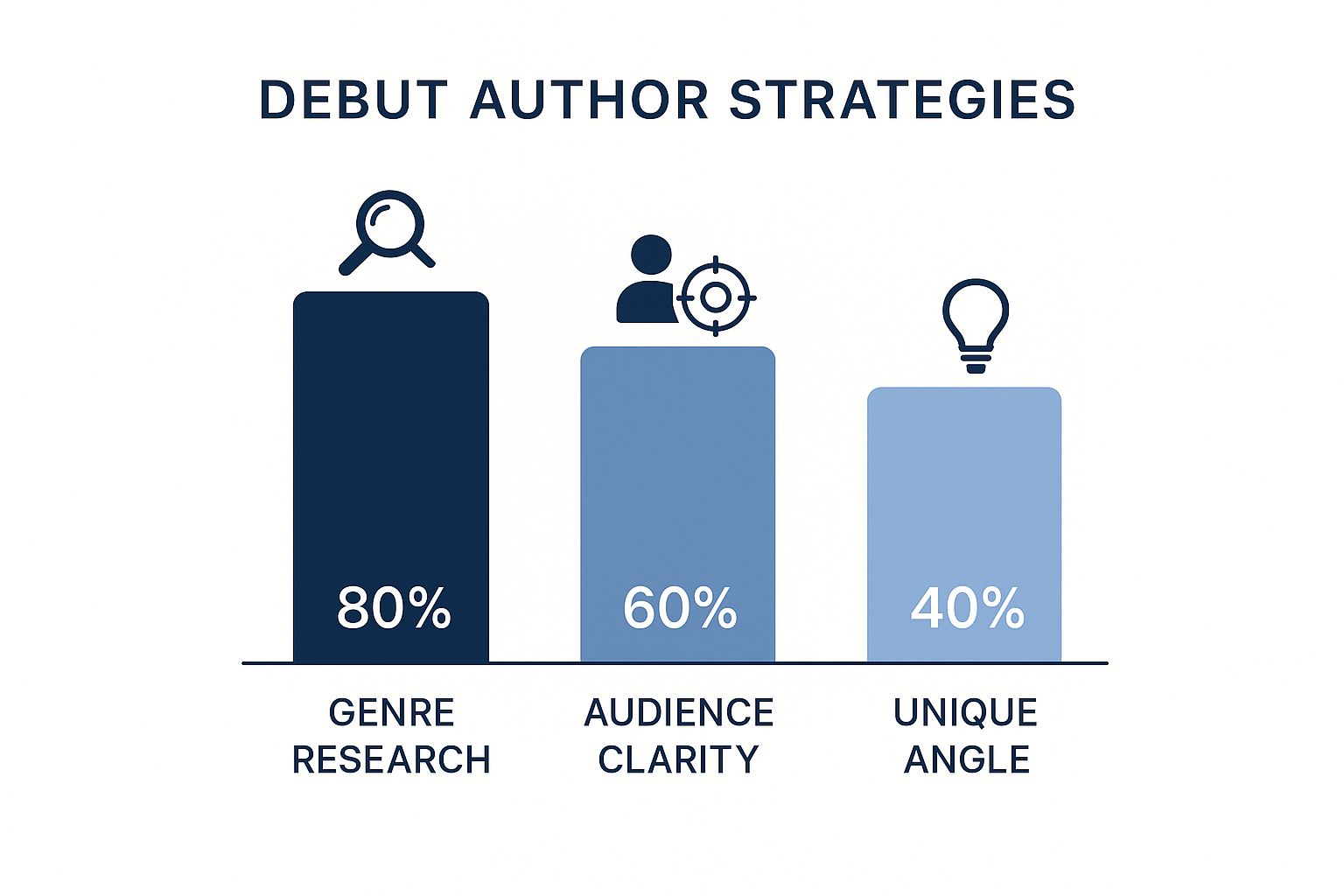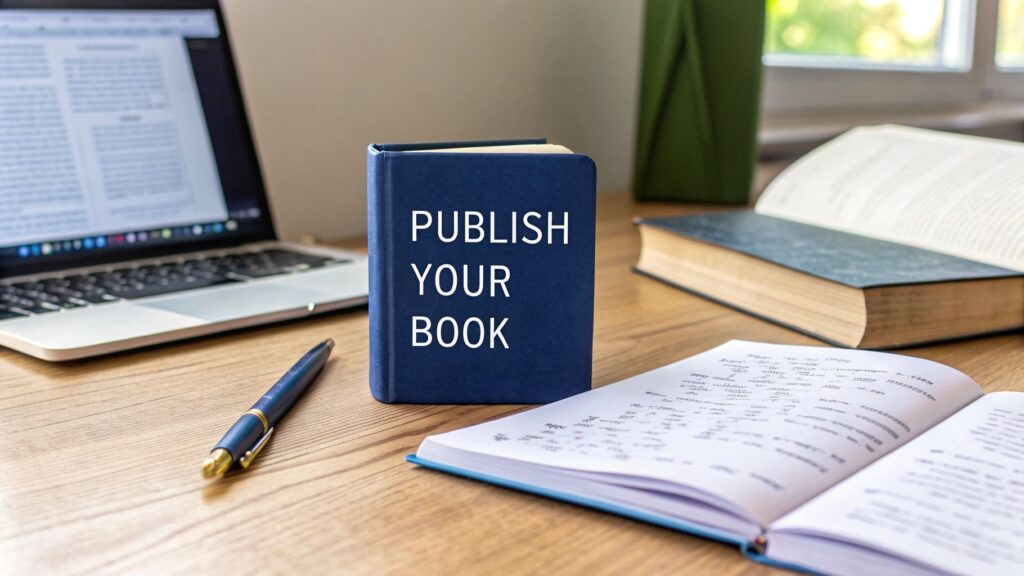So, you've written a book. The journey from a finished manuscript to a published book might seem daunting, but it really boils down to a few key stages: perfecting your manuscript, deciding on your publishing path, and finally, launching your book into the world.
Getting a handle on these core steps is the first real move toward seeing your name on a cover.
Your Publishing Roadmap: From Manuscript to Market
Before we get into the nitty-gritty of editing, cover design, or marketing plans, let's zoom out. The single most important decision you'll make at the start is how you're going to publish. Will you go the traditional route or self-publish? This choice dictates everything that comes next—your timeline, your budget, your level of creative control, and how you'll eventually get paid.
One path means finding a literary agent to champion your work and pitch it to big publishing houses. The other puts you firmly in the driver's seat, where you manage the entire show yourself. There’s no right or wrong answer here. The best route is the one that fits your goals, your bank account, and how much you want to steer the ship.
Charting Your Course: Traditional vs. Self-Publishing
Many writers dream of the traditional route. It carries a certain prestige and comes with the backing of a professional team. But let's be real: it's a long, competitive road. From the day a publisher says "yes," it can still take 12 to 24 months for your book to actually hit shelves. And getting that "yes"? With acceptance rates at major publishers often dipping below 1%, the odds are tough. For a deeper dive, you can explore more on the book publishing market's dynamics to understand what you're up against.
Self-publishing, on the other hand, is all about speed and autonomy. You keep all your rights and have the final say on everything. Your book can be live and available to readers worldwide in a matter of weeks, not years. The trade-off is that you become the project manager. You're responsible for hiring editors, designers, and running your own marketing campaigns.
To help you weigh these options, here's a quick side-by-side comparison.
Traditional Publishing vs. Self-Publishing at a Glance
| Factor | Traditional Publishing | Self-Publishing |
|---|---|---|
| Creative Control | Low. Publisher has final say on editing, cover design, and title. | High. You have complete control over every aspect. |
| Upfront Cost | None. Publisher pays for everything. | High. You fund all editing, design, and marketing costs. |
| Time to Market | Very long (12-24 months or more after signing). | Very fast (weeks or even days). |
| Distribution | Strong, with potential for physical bookstore placement. | Primarily online, with print-on-demand for physical copies. |
| Royalties | Lower (typically 5-15% of net receipts). | Higher (typically 40-70% of the sale price). |
| Prestige/Validation | High. Comes with the backing of a known publisher. | Varies. Built through reviews, sales, and author brand. |
| Marketing Support | Varies. Major support for lead titles, minimal for others. | All on you. You are solely responsible for marketing. |
Ultimately, this table shows there's a clear trade-off between control and support. Your personal goals will determine which set of compromises makes the most sense for you and your book.
No matter which path you're leaning toward, success starts with understanding where your book fits in the market. Look at what successful authors do before they even think about querying or uploading.

As you can see, a huge majority of authors do their homework first. They know their genre, they know who they're writing for, and they know what makes their book special. This isn't just busy work; it's the foundation of a successful launch.
Key Takeaway: Your publishing journey doesn't start with an agent search or a file upload. It begins with a strategic decision: traditional or self-publishing? Choosing the path that aligns with your vision for the book—and your career—is the most important first step you'll take.
Polishing Your Manuscript Until It Shines

Before you even dream of seeing your book on a shelf, your manuscript needs to be more than just "done." It has to be polished to a professional gleam. This isn't just a suggestion; it's a non-negotiable part of the journey. A raw, unedited draft sends a clear signal to agents, publishers, and even early readers that you haven’t fully committed to your own project.
Think of it this way: a finished manuscript is the raw diamond. Editing is the process of cutting and polishing it to reveal its brilliance. It’s what separates a promising idea from a market-ready book. This goes way beyond a simple spell check—it’s a multi-layered process, and skipping a step is like building a house with a shaky foundation. The flaws will always find a way to show through.
The Four Essential Layers of Editing
Professional editing isn't one single task; it's a sequence of reviews. Each type of editor examines your work through a different lens, starting with the big-picture view and drilling down to the tiniest details. If you're just starting out, a solid guide to writing books for beginners can help you create a strong first draft before you even get to this stage.
Once that draft is complete, it's ready to pass through these crucial phases:
-
Developmental Editing: This is your big-picture review. A developmental editor looks at the very bones of your book. For a novel, they’re digging into plot structure, character development, pacing, and overall narrative arc. For non-fiction, they’re scrutinizing your core argument, the flow of information, and chapter organization. Their one job is to answer the question: Does this book work on a fundamental level?
-
Line Editing: With the structure confirmed, the line editor zooms in. They work sentence by sentence, honing your voice and style. Their focus is on improving clarity, tightening up clunky phrasing, and making your prose more powerful and engaging. This is where your writing's unique flavor really comes to life.
-
Copyediting: Now we get technical. The copyeditor is your grammar and consistency guru. They hunt down errors in spelling, punctuation, and syntax. They're the ones who ensure a character's eye color doesn't mysteriously change in Chapter 15 and that your timeline makes perfect sense from start to finish.
-
Proofreading: This is the final, pre-flight check. After the manuscript has been designed and formatted into its final layout, a proofreader does one last sweep. They catch any lingering typos or formatting glitches that were missed or, more commonly, introduced during the design process.
How to Find and Vet the Right Editor
Finding a good editor can feel like searching for a needle in a haystack, but freelance platforms and professional organizations are fantastic starting points. When you find a potential candidate, always ask for a sample edit.
Most professionals will edit a small portion of your work (usually 1,000-1,500 words), sometimes for a small fee, sometimes for free. This is your chance to see their skills in action and—just as importantly—to see if you connect with their feedback style.
An editor's purpose isn't to rewrite your book in their voice. It's to help you sharpen and elevate yours. You're looking for a partner who gives clear, constructive criticism that empowers you to make the final call. The best editors don't just fix your manuscript; they make you a better writer.
Learn to Love Feedback (and Self-Edit First)
Getting a document back full of red ink can sting, but try not to take it personally. My best advice? Let the editor’s notes sit for a day or two before you dive in. This gives you the emotional distance to evaluate the feedback objectively and separate your ego from the work.
You can also save yourself a significant amount of money and time by doing a thorough self-edit before you hire anyone.
- Read your work out loud. This is the single best trick for catching awkward sentences and stilted dialogue. If you stumble over a line when you say it, your reader will stumble when they read it.
- Use software as a first pass. Tools like Grammarly or ProWritingAid are great for catching low-hanging fruit, but they are no replacement for a human eye that understands context, tone, and nuance.
- Create some distance. After you finish writing, put the manuscript away for a few weeks. When you come back to it, you’ll have fresh eyes, making it far easier to spot plot holes, weak descriptions, and repetitive phrasing yourself.
This meticulous, layered process is what turns a passionate writer into a published author. It's an investment in your craft and one of the most critical steps toward creating a book that can stand proudly on any bookshelf.
Navigating the Traditional Publishing Path
For many writers, the ultimate goal is seeing their book on a shelf in a major bookstore. This dream of a traditional publishing deal—with a big-name press and the industry validation that comes with it—is a powerful motivator. But it's also incredibly competitive. The key is to shift your mindset: you aren't just selling a story; you're pitching a viable commercial product to a literary agent.
Your journey starts with a single, crucial document: the query letter. Think of it as a one-page sales pitch for both your book and yourself. It’s often your only shot to grab an agent’s attention, so every single word has to earn its place. The whole point is to hook them in the first few sentences, lay out your book's premise, and show them you know exactly where it sits on the bookstore shelf.
A solid query letter generally has three parts:
- The Hook: A sharp, one- or two-sentence pitch that immediately establishes the story's core conflict and stakes.
- The Mini-Synopsis: A short paragraph summarizing the plot. Introduce your main character, what they want, what stands in their way, and the consequences of failure. Keep it tight and focused.
- Author Bio & Comps: Briefly share any relevant writing credits. Most importantly, include two "comp titles"—recent, successful books that have a similar tone or audience to yours. This shows agents you understand your market.
Finding the Right Agent
Blanketing every agent on the internet with your query is a surefire way to get ignored. Success comes from smart, targeted research. You need to find agents who are actively looking for books in your specific genre and have a proven history of selling them. Websites like QueryTracker and Publishers Marketplace are invaluable for this. I also tell authors to flip to the acknowledgments section of books they love—writers almost always thank their agent there.
Once you’ve built your list, read each agent's submission guidelines as if your career depends on it—because it does. One agent might want the first five pages, another the first ten, and a third might ask for a separate synopsis. Ignoring these rules is the quickest way to land in the trash folder.
One of the most common mistakes I see is authors querying agents who don't even represent their category. Sending your sci-fi epic to an agent who only sells historical romance is a waste of everyone's time. A little personalization proves you've done your homework and are a professional.
The Author-Agent Partnership
If an agent connects with your query, they'll ask to see the full manuscript. If they fall in love with your book, they'll offer you representation. This is a formal partnership where the agent agrees to champion your book to publishers in exchange for a commission, which is typically 15% of what you earn from the deal.
Your agent is now your business partner. They'll likely give you another round of feedback to get the manuscript into fighting shape before they send it out on submission to editors at publishing houses. This part of the process can take months, and you should expect to hear the word "no." A lot. That’s just how it works. Learning how to become a published author is an exercise in both perseverance and developing a thick skin.
Handling Rejection and Staying the Course
Rejection is simply part of the job description in traditional publishing. Every bestselling author you can name has a folder—or a drawer—stuffed with rejection letters. The trick is to see it as feedback, not a final verdict on your talent.
When a "no" comes in, give yourself a moment to be disappointed, then get clinical. Is there useful feedback in the email? If you hear the same critique from multiple agents—maybe the opening is too slow or the stakes aren't clear—that’s a strong sign you need to go back and revise.
The road to a traditional book deal is a marathon, not a sprint. It requires patience, professionalism, and a stubborn belief in your story. By crafting a knockout query, targeting the right agents, and learning to handle rejection with grace, you give yourself the best possible shot in a tough but incredibly rewarding industry.
Taking Control With Self-Publishing

If you're finding the traditional publishing path feels a lot like waiting for someone else to give you permission, you're not alone. Self-publishing is the alternative where you stop waiting and start doing. This route puts you squarely in the author-publisher’s chair, giving you the final say on everything—your content, the cover design, when you launch, and how you price it. It's a faster, more direct way to get your book into your readers' hands.
Of course, there's a trade-off. With this much control comes a lot more responsibility. You become the project manager, marketing director, and production chief all at once. Every single step, from final edits to making the sale, falls on your shoulders.
But the financial upside can be massive. While traditional publishing royalties often land somewhere between 8% and 15%, as a self-published author, you could earn royalties from 35% all the way up to 70% on every sale. That higher income potential is a direct reflection of the work you put into the editing, design, and marketing yourself.
Choosing Your Self-Publishing Platform
Your first big decision as an author-publisher is picking where you'll actually publish your book. The two heavyweights you'll hear about most are Amazon Kindle Direct Publishing (KDP) and IngramSpark. They each have their own strengths, and the one you choose will have a real impact on your book's reach and your bottom line.
-
Amazon KDP: This is the undisputed giant of the online book world. Publishing with KDP is free and gives you immediate access to Amazon’s enormous global customer base. It's the go-to for most new authors simply because it's user-friendly and comes with powerful, built-in promotional tools.
-
IngramSpark: Think of IngramSpark as the distribution powerhouse. While KDP is focused on the Amazon ecosystem, IngramSpark can get your book listed with a network of over 40,000 retailers, libraries, and independent bookstores across the globe. There's a small setup fee, but the trade-off is much, much broader reach.
A common strategy many seasoned authors use is a hybrid approach: publish on KDP to maximize royalties from Amazon sales, and use IngramSpark to handle distribution to everyone else. It's the best of both worlds.
Securing Your Book’s Identity
Before you can upload your masterpiece anywhere, it needs a unique identifier. This is where the ISBN (International Standard Book Number) comes in. It’s essentially your book's Social Security number, and it’s non-negotiable for tracking sales through retailers and libraries.
Platforms like KDP will offer you a free ISBN, but there's a pretty big catch: they will be listed as the official publisher. When you buy your own ISBN, you can create your own publishing imprint, which looks far more professional and gives you total control over your book's data across every platform. If you're serious about building an author career, owning your ISBN is a smart move. You can learn more about how to get an ISBN for my book and decide what's right for you.
Key Takeaway: Owning your ISBN isn’t just about a number—it’s about owning your publishing identity. It establishes you as the publisher, not Amazon, which is a critical piece of building a sustainable author brand.
Mastering Your Book Metadata
Metadata is simply all the information that describes your book, and getting it right is the secret sauce to discoverability. It's how readers—and, just as importantly, store algorithms—find you. This includes your title, author name, book description, keywords, and categories.
Think of your book description as your online sales pitch. It needs to grab attention, focus on what the reader gets out of it, and be peppered with the kinds of keywords people would actually type into a search bar. Don't just rehash the plot; hook them emotionally.
Keywords and categories are your secret weapons. KDP gives you seven keyword slots and lets you select multiple categories. Do your homework here. See what the best-selling books in your genre are using for their categories and keywords. This isn't cheating; it's smart market research. Picking the right, less-crowded categories can give your book a massive visibility boost, helping it get noticed in a very crowded digital bookstore.
Bringing Your Book to Life with Professional Design
Let’s be honest. Your book is more than just the words you’ve poured your heart into; it's also a product. And the very first thing a potential reader will ever see isn't your brilliant opening line—it's your cover. In the vast ocean of online and physical bookstores, your cover is your single most important marketing tool.
This holds true whether you’re going the indie route or landing a deal with a big publisher. A fantastic cover immediately signals quality and promises the reader an experience that fits the genre they love. A bad one? It can kill your sales before anyone even reads the blurb.
Your Book Cover Is Your Best Salesperson
Picture someone scrolling through Amazon or wandering the aisles at Barnes & Noble. Your cover has maybe two seconds to catch their eye. That's it. This is precisely why getting it right is non-negotiable.
A professional designer knows the subtle visual cues of your genre. They understand the difference between the sharp, bold fonts of a thriller and the soft, flowing scripts of a historical romance. They’re experts in the visual language that tells a reader, "This book is for you."
When you start working with a designer, you need to give them a solid brief.
- Provide Comp Titles: Don't just pick any books; find recent bestsellers in your specific subgenre. This shows the designer what's currently resonating with your target audience.
- Talk About Mood and Theme: Go beyond a simple plot summary. Is your story dark and brooding? Uplifting and hopeful? What is the core emotional journey you want to convey?
- Insist on Readability: This is a big one. The title and your name must be crystal clear, even when viewed as a tiny thumbnail on a phone. If a reader has to squint, you've already lost them.
A professional cover isn't just an expense; it's a direct investment in your book's visibility. A great design can dramatically increase how many people click on your book, which translates directly into sales.
The Interior Design Dictates the Reading Experience
While the cover makes the first sale, the interior layout—what we call typesetting—is what keeps the reader happily immersed in your world. Nothing pulls a reader out of a story faster than a poorly formatted book. Think awkward line breaks, a font that's hard to read, or sloppy chapter headings.
Really good interior design should be invisible. Its job is to create a seamless and enjoyable reading journey. This involves choosing the right font (serif fonts like Garamond are a classic choice for print), setting clean margins, and designing simple, elegant chapter openings.
If you’re self-publishing, tools like Vellum or Atticus are game-changers and can make this process much easier. For books with more complex needs, like lots of images or unique formatting, hiring a professional interior designer is worth every penny. For those on a traditional path, your publisher's team will handle this, but you’ll still get to review and approve the final proofs. Don't rush that step.
Finding and Working with Freelance Designers
As a self-published author, you're the project manager, which means you'll be hiring your own designer. Where do you find them?
Platforms like Reedsy and 99designs are fantastic starting points. Even better, ask for referrals within your author community. Seeing who other authors in your genre trust is often the best vetting process.
Before hiring anyone, dive deep into their portfolio. Does their style actually match the vision you have for your book? Get a clear quote and an estimated timeline upfront. A simple contract that outlines the number of revisions, the final files you'll receive, and payment terms will save you a world of headaches down the road. Clear communication is what will ultimately transform your manuscript into a book that looks every bit as good as the story inside.
Launching and Marketing Your Book for Success

Congratulations, your book is finally ready for the world. But here's a hard truth many authors learn too late: hitting "publish" isn't the finish line. It's the starting gun. The real work of connecting your book with its ideal readers begins now.
A successful launch is never an accident. It’s the direct result of a smart, well-timed marketing plan that you start building long before your release date. Think of it less as a final chore and more as a parallel project you're working on as you finish the book. Your goal is to build a groundswell of anticipation so that on day one, you have people ready and waiting to buy.
Build Your Author Platform Early
Your author platform is your personal megaphone, your direct line to readers. It’s the space you own online, where you can build a genuine community without being held hostage by an ever-changing algorithm. The two non-negotiables? An author website and an email list.
Your website acts as your professional hub—it’s where agents, publishers, and readers can find your bio, learn about your books, and read your blog. But its most critical job is to funnel people to your email list. Offering a compelling freebie, like a bonus chapter, a character interview, or a resource guide, is the best way to convince readers to subscribe.
Key Takeaway: Your email list is, without a doubt, your most valuable marketing tool. Forget vanity metrics. An email list of just 1,000 true fans can generate more sales on launch day than a passive social media following of 10,000. These are your people.
Create Buzz Before and During Launch Week
The period surrounding your launch is all about building and sustaining momentum. This is where all your early groundwork really pays off.
Your strategy should be a flurry of planned activity:
- Secure Early Reviews: Get Advance Reader Copies (ARCs) into the hands of potential reviewers and influencers weeks before the launch. Having a handful of positive reviews on Amazon or Goodreads on day one provides powerful social proof and can make a huge difference in convincing a hesitant buyer.
- Leverage Social Media: Go beyond just posting "my book is out!" Share the entire journey: the cover reveal, snippets of your writing process, countdown graphics. A structured approach is crucial here. Use a winning sample social media marketing plan as a guide to keep your efforts organized and effective.
- Run Launch-Day Promotions: Many successful authors launch their ebooks at a discount—say, $0.99 or $1.99—for the first few days. This surge of initial sales can help you climb the bestseller charts in your category, which dramatically increases your book's visibility to new readers browsing the store.
Sustain Momentum Post-Launch
A great launch isn't just about a big first week. It’s about setting your book up for long-term, sustained sales. Once the initial launch-week buzz quiets down, your focus needs to shift to evergreen strategies. When you feel like you've run out of steam, exploring a fresh list of book promotion ideas can be just the jolt of creativity you need.
This is a good time to experiment with targeted ads on platforms like Amazon or Facebook to reach new readers who fit your specific audience profile. Keep nurturing your email list with exclusive content and updates on what you're writing next. Remember, every book you publish helps market the others. You’re not just launching a single book; you’re building a lasting career.
Answering Your Lingering Publishing Questions
As you get closer to the finish line, a few common questions always seem to pop up. They’re the practical, nuts-and-bolts details that can feel overwhelming, but getting them sorted out is key to publishing with confidence.
Let’s start with the big one: money.
What Does It Really Cost to Self-Publish?
This is probably the most frequent question I hear, and the honest answer is: it depends. You could theoretically publish for next to nothing, but if you want a book that can stand shoulder-to-shoulder with traditionally published titles, you’ll need to invest.
The cost can swing from a few hundred dollars to several thousand. The main drivers of your budget will be:
- Professional Editing: This is non-negotiable and your biggest expense. It covers everything from big-picture story development to sentence-level polishing.
- Cover Design: People absolutely judge a book by its cover. A pro design is your single most important marketing tool.
- Interior Formatting: A clean, professional layout for both print and ebook versions makes the reading experience seamless.
So, what's a realistic number? For a high-quality, professional-grade book, I tell authors to plan for a budget in the $2,000 to $5,000 range. This investment pays for itself in credibility and reader satisfaction.
Agents, ISBNs, and Other Essential Details
"Do I need an agent?" is another common crossroads for authors. If your dream is to land a deal with one of the big New York houses—think Penguin Random House or Simon & Schuster—then yes, an agent is your only way in. They almost never look at manuscripts that come in "over the transom" (unsolicited).
But for self-publishing? You don't need an agent at all. The same goes for most small, independent, or hybrid presses, which often accept direct submissions.
This brings us to a crucial piece of the puzzle: the ISBN.
An ISBN (International Standard Book Number) is a unique 13-digit code that identifies your book to retailers, libraries, and distributors worldwide. If you intend to sell your book, you absolutely need one.
Some platforms like Amazon KDP will give you a "free" ISBN. It's a tempting offer, but there's a catch: they'll be listed as the publisher. For true independence and a more professional look, I always recommend buying your own ISBN. This lets you create your own publishing imprint and gives you complete control over how your book is listed everywhere.
Ready to turn your manuscript into a professionally published book available worldwide? At BarkerBooks, we handle every step of the process, from editing and design to global distribution and marketing. Learn more about our publishing packages and start your journey today.
